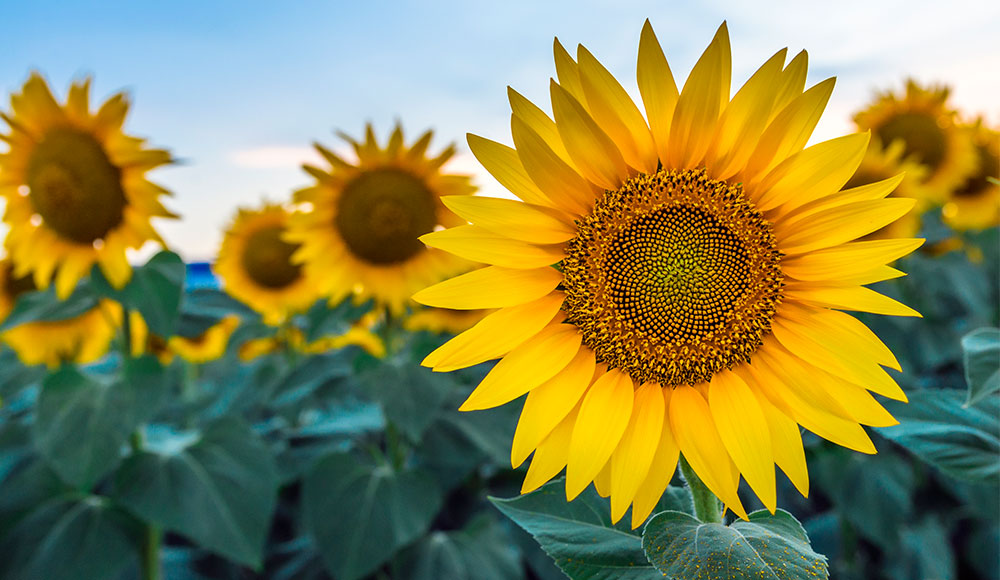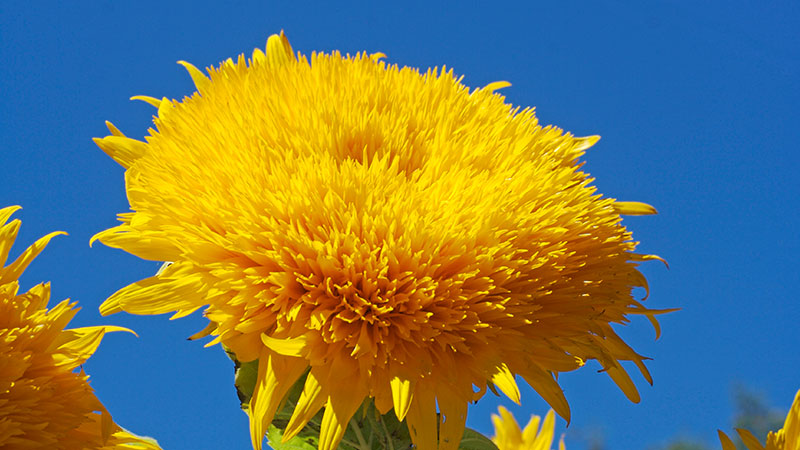


By Gilmour
Nothing says summer like bright rows of brilliant Helianthus flowers, commonly known of as sunflowers. Easy to grow, this North American native is a fun plant to add to your vegetable or flower garden. Most people think of sunflowers as the towering varieties filling fields in the prairie states. However, many garden cultivars are designed to be compact and grown in a wide range of hardiness zones. You can choose sunflowers in many different colors featuring heights between 4 to 12 feet.
Often seen as a border plant to give height to the back of a flower bed, sunflowers are multipurpose. They provide beauty to your garden and are a food source for birds and squirrels. Cutting them brings their sunny faces inside for floral arrangements. Many sunflowers feature big, beautiful blooms and can be harvested for their tasty seeds or a rich sunflower oil. If you’re wondering how to plant sunflowers and how to take care of sunflowers in your garden, look no further. All you need is a few simple tips to get the most out of your garden sunflowers.
Planting sunflower seeds is a quick and easy task. By taking the time to choose the right location and prepare the soil, you give these plants the strongest possible start.
It almost goes without saying that sunflowers love the sun. Look for a spot with plenty of sun for these fast-growing annuals. Think about what you’ll plant around or near your sunflowers. Most sunflowers grow quite tall and may cast shade on other plants. The short growing season of between 70 to 100 days allows for planting throughout most gardening zones.
Well-draining soil is essential. If your soil is heavy, mix in up to 4 inches of compost. Add nutrients to soil with a complete fertilizer prior to planting. Mix your compost and fertilizer into the top 6 inches of your garden bed. Slightly acidic soil with a pH between 6.0 and 7.5 is ideal. A home soil test can help you determine what your garden soil needs.
Choosing when to plant sunflower seeds requires a bit of waiting. Plant sunflowers in late spring, once the ground is nice and warm. Most sunflowers germinate when soil has reached 70 to 85 degrees F. The best time to plant sunflowers is just before the soil reaches this temperature. Look for a ground temp of between 60 to 70 degrees. For most areas, this will be approximately three weeks after the last frost. Planting sunflowers indoors gives you a head start on the growing season. Simply tuck the seeds into peat pots around the time of your last spring frost. They should be the right size for transplant once the soil is the appropriate temperature.
Different sunflowers require different planting depths and spacing. How to grow sunflowers from seed and how deep to plant sunflower seeds depends on your specific sunflower cultivar. In general, plant sunflower seeds at least 1/2 inch deep. Space seeds 6 inches apart. If planting in rows, you’ll want 2 to 3 feet between each row. Plants should be thinned out in a few weeks to the proper spacing. If soil temperatures are just right, sunflower seedlings will sprout up in 10 to 14 days.
Growing sunflower seeds requires space. To start sunflowers indoors, plant three seeds per each 3- to 4-inch peat pot. A soilless planting media will give you the best drainage. Indoor germination usually happens in 6 to 10 days. You can enjoy continuous blooms through summer by planting seeds every couple of weeks. With consecutive plantings, you’ll have beautiful sunflower blooms right up until the first frost of fall.
Because sunflower seeds contain large amounts of natural oil, they require a lot of water for germination. After planting, water the ground thoroughly. Keep the soil moist with frequent, light watering until germination occurs. If starting indoors, cover your pots with clear plastic wrap to keep in moisture. Remove the plastic as soon as the seeds sprout.
Once the sunflower seedlings have their first set of true leaves, thin the seedlings to the recommended row spacing for your variety. Small sunflowers may require only 6 inches between each plant, while large varieties might need up to 3 feet. Closer spacings are possible for garden aesthetics, but crowded plants will produce smaller flowers.
Indoor sunflower seedlings should be reduced to one seedling per cup. Simply choose the strongest sunflower and pinch back the others.
Learning how to grow sunflowers isn’t difficult – they almost grow themselves. And once sunflowers begin to grow, they grow quickly. Sunflower care only requires a few basic growing tips.
Although sunflowers require a lot of water to germinate, they only require an inch of water per week during the growing season. Use a watering nozzle to easily water once a week until the top 6 inches of soil is moist.
If you prepared your soil with compost and/or manure, you shouldn’t need extra fertilization during the growing season. If you feel your plants require better nutrition, you can work a balanced, slow-acting granular fertilizer into the soil surrounding your sunflowers. Sunflower fertilizers are available in a few garden centers, but a basic fertilizer is really all you need.
One of the greatest sunflower challenges is weed control. Weeds compete with sunflowers for moisture and nutrition. Unless you want to till, hoe or pull weeds by hand, you’ll want to put down a generous layer of mulch to fight weeds. Add up to a 4-inch layer of organic mulch to your sunflower garden. Leave an area of bare soil around each sunflower stalk to help deter pests and disease.
Although many pests love sunflower plants, the damage is usually minimal. In most cases, insecticides are not necessary unless damage is severe. Most sunflowers rely heavily on insect pollinators, so care should be taken to limit any use of insecticides during pollination. Some pests you may encounter are sunflower moths, cutworms, weevils, caterpillars, grasshoppers, wireworms and the sunflower maggot.
Disease is a big risk, but it mostly affects farm crops. New varieties of sunflowers have resistance to many diseases. Once disease occurs, the only option is to remove and destroy the affected plants. Verticillium wilt, sclerotinia rot, rust and downy mildew may occur. Your best prevention is proper plant spacing in well-draining soil.
When growing seeds for harvest, birds can become an issue. Scarecrows, owl decoys and shiny metal pie plates can help deter birds. You can also plant certain oil-rich cultivars, such as Black Peredovik, to keep birds away from your seed sunflowers.
Harvesting sunflower seeds is the perfect way to enjoy both the beauty of the flowers in your garden and their delicate seeds. Sunflowers produce a bounty of seeds that can be added to breads, eaten on salads or even turned into a creamy nut-free sunflower butter. Growing a seed production variety will increase your harvest of edible sunflower seeds. Expect to harvest seeds approximately 30 days after pollination.
You’ve spent all this time learning how to grow sunflower seeds – don’t let the birds eat your harvest! Begin checking for seed maturity in early fall. The seeds will begin to face towards the ground as the flower petals dry and fall out. Once ready, simply cut off seed heads with a generous amount of stem attached. Hang in a warm, dry place away from rodents and insects.
Wait until the back of the sunflower head turns brown before harvesting the seeds. Although you can pick out mature seeds earlier, the browning of the head allows for the easiest and quickest removal.
Seeds naturally fall out of the flower heads as they dry. To catch all the seeds you can, place netting or a paper sack with air holes over each head.
Once thoroughly dry, seeds are easy to remove. You can grab a sunflower head in each hand and rub their faces together to dislodge the seeds. Or, you may be able to simply brush seeds out with your hands or a stiff brush.
To keep sunflower seeds as fresh as possible, store in airtight glass jars in the refrigerator. This keeps moisture levels low. If storing outside of the refrigerator, consider adding desiccant packages to absorb excess moisture. Many people store raw seeds in cloth bags in dark, dry areas to encourage air circulation.

Sunflowers come in a wide range of sizes and colors. Some of the most popular garden sunflowers include:
Sunflowers need full sun for the best growth. Although only six hours of sun is required, the more sun a sunflower gets, the better the growth. If you crowd plants too closely together, the leaves will be starved for sunlight. This causes the plant to grow too quickly and produce weak stems as plants reach up for more light.
Sunflowers grow quickly. Many can achieve up to 12 feet of growth in only 3 months. With the proper growing conditions, sunflowers should reach maturity in 70 to 100 days after planting.
Most sunflowers are annuals. They germinate in late spring, bloom during the summer and die back at the first frost of fall. When considering how to grow a sunflower that lasts all summer, the best plan is to plant your sunflowers every few weeks to extend bloom time.
While most varieties of this bright beauty are annual sunflowers, meaning they will not come back the following growing season, they may self-germinate from dropped seeds if you leave the heads on the plants throughout the winter. The perennial Maximillian sunflower features small blooms in late summer and early fall. It can be grown as a perennial up to hardiness Zone 3.
You can grow many small varieties of sunflowers in pots and containers. Dwarf sunflowers are perfect for growing in pots. Instead of featuring one sunflower on a single stalk, dwarf varieties are bushy and may feature more than one bloom per plant. The sunflowers grow up to five inches in diameter on stalks up to three feet tall. No need to wonder about how to care for sunflowers in pots, this annual plant has the same needs for water, fertilization and sunlight in either gardens or containers.
When sunflowers are young they exhibit heliotropism. This means their flowering heads track the sun as it moves across the sky. As the stem matures and becomes woody, the tracking usually becomes less noticeable. The leaves may still follow the sun, but the flower will not. In many varieties, maturity causes the sunflower to face the ground, which reduces the risk of bird damage.
From the moment you pick it up, you’ll notice these nozzles are different. Designed with mobility in mind, they feature Gilmour’s innovative Swivel Connect. The swivel allows the nozzles to pivot without
Learn MoreWinter Gardening Tips to Tackle in the Off Season
As winter marches on, avid gardeners become more and more eager to get growing. While you may not be able to dig your spade into the soil just yet, there is plenty
Learn MoreDesign a Beautiful Drought Resistant Yard
Hot weather and drought-like conditions don’t mean a beautiful yard and garden is out of reach. Learn everything you need to know about drought tolerant landscaping, including the best type of plants,
Get the Dirt